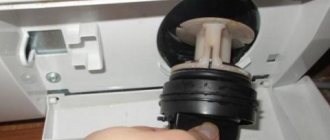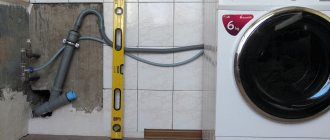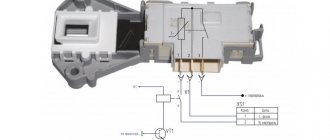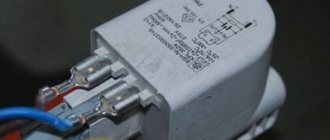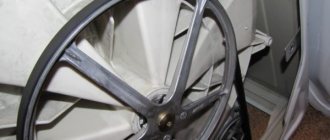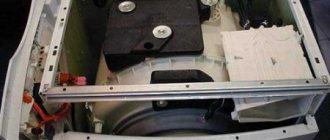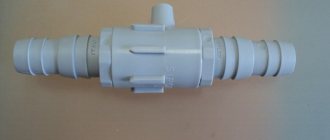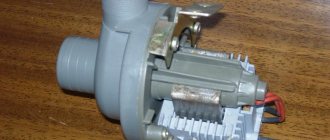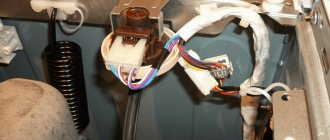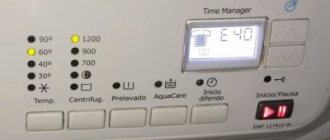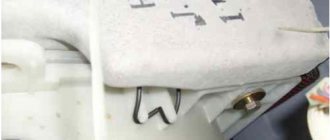Decision-making
Before you start work, it is important to decide and make the right decision.
What factors make sense to take into account?
- Most modern apartments are small. At the same time, there is usually not enough space in the bathroom. Therefore, installation in the kitchen is not so much a matter of convenience as it is of necessity.
- An important point can be considered the separation of bathroom functions. If laundry can be done in the kitchen, there is no need to wait for the shower to stop occupying it. And if we talk about those apartments where the bathroom is combined with a toilet, then this issue is even more important.
- Don't forget about the danger of corrosion. The humidity in the bathroom is traditionally high, and this can damage the metal parts of the washing machine. In the kitchen, this factor is much weaker.
- It often happens that more space is created in the kitchen for a washing machine. This gives greater freedom when choosing the most suitable model.
- The kitchen is the only place in the apartment, besides the bathroom, where all the necessary communications are initially present.
Although the solution may be different in different situations, in most cases, the above reasons speak in favor of placing the machine in the kitchen.
Kitchen. We are exploring a place for the typewriter
What space should I allocate for the washing machine?
It is more convenient to place the washing machine under the countertop in the same kitchen, or to place the top-loading machine somewhere in the corner.
It is even possible to install two machines on top of each other in a niche in your built-in kitchen. Your kitchen room can be divided into 2-3 compartments (in continuation of the kitchen), where there may be a laundry room, in which washing machines will naturally be built-in.
During the renovation, you can use the “country” style, in which you can install a front-facing washing machine. In a fairly large and spacious kitchen, it is often possible to store machines and laundry detergents in a cabinet in the kitchen niche.
The most important thing is to place your structure correctly in order to be able to install a dining table, various kinds of decorations in your kitchen, or simply leave yourself some space.
The kitchen room is most subject to experiments in installing various household appliances. For example, you can install microwave ovens, dishwashers, etc.
What are the benefits of installing a washing machine in the kitchen?
Every modern housewife dreams of a modern, fairly functional kitchen, which will be stuffed with household appliances of various types. All women want a kitchen with built-in appliances; it is quite convenient and elegant.
Your bathroom probably has very little space. If, for example, if you want to install a larger structure, then it is best to install the washing machine in the kitchen. It’s better to carefully consider all the options before installing a washing unit in the kitchen, because you may want to hide it with a movable panel or door. You can create a kitchen island with your own hands, in which you can place your design.
Kitchens with built-in washing machines are convenient to use, since everything is done within the same place. Also, in this option, you comply with all safety rules, since the bathroom has quite high humidity, and installing a washing unit there is not very safe, because a fire or equipment breakdown is possible if it comes into contact with water, which can gush out at the moment when someone bathes in the shower. Therefore, installing the unit in the kitchen is quite an economical option for all purposes.
Features of the kitchen interior
No one has any doubts that the installation of household appliances (including a washing machine) in the kitchen is very stylish and quite original. The machine can be hidden from prying eyes in a closed room or a window can be made at the front of the structure. It is quite possible to match the color of your machine to your kitchen furniture.
A fairly large number of modern products do not allow you to gather your thoughts and finally choose the design of your kitchen room due to its diversity, but if you succeed, then you can get the desired kitchen of your dreams.
Model selection
Even if the installation issue has been resolved in principle, it is very important to choose the right model.
- There are front-loading machines and there are vertical-loading machines. The latter are much less convenient for the kitchen. Typically, the top surface is covered with a countertop, and the front is open for loading laundry.
- Modern built-in models provide reduced vibration, which is combined with fairly high power during operation. If you cover it with a countertop, then you can cook food here or, for example, place a microwave.
- Although it may seem unusual, in some cases (especially for very small kitchens) the option of placing the machine directly under the sink may be considered. In this case, the height of the washing machine should not be more than 60 centimeters.
Washing machine sizes
All washing machines are divided into the following types by size:
- full size;
- narrow;
- compact.
The smaller the body of the equipment, the more organically it will fit into the furniture set. But do not forget that the drums of small models do not have a large capacity.
Do you turn off the water tap after washing?
Oh yes! No.
The parameters of front-loading washing machines can be described as follows:
- The depth of the device ranges from 30 to 60 cm. The standard size is 50 cm. Depth is a key indicator on which the capacity of the drum depends.
- The width usually corresponds to 60-85 cm. Narrow models with a large load are in demand.
- The height of the front panels is the same - 85 cm. There are lower models on sale, designed for installation under the sink.
The dimensions of machines with a vertical loading type can be summarized as follows:
- The depth ranges from 40 to 45 cm. The absence of a hatch on the front panel allows you to install devices in small niches.
- The width of the housing is usually 60 cm. So the machines do not take up much space in the room.
- The standard height, like that of front cameras, is 85 cm.
Expert opinion
I work in the household appliance repair industry. Extensive experience in restoring washing machines and dishwashers.
Ask a Question
Integrating top-loading models requires more creativity. An original solution would be to install the machine under a bar counter with a folding tabletop.
Planning
In order to successfully implement your plans, it is very important to plan everything correctly. Many apartments, especially those built during the Khrushchev era, do not have much space.
Therefore, the very first task that faces us is to think about the arrangement of furniture in the kitchen, taking into account the fact that they are going to put a washing machine there. But there is one subtlety here.
The appearance of the washing machine is much more modern compared to various pieces of old furniture. A harmonious combination between them is unlikely to happen. Therefore, it is a smart decision to install the machine when updating the entire kitchen furniture.
Let's proceed directly to planning.
- You need to prepare a blank sheet of paper and a pen or pencil. When allocating space, you need to take into account the dimensions of all the furniture that should be in this room.
- The next step is to take measurements. In this case, you need to take into account the size of both the kitchen itself and each piece of furniture that is located there.
- It is convenient to start placement in order to distribute the largest items. If there are a lot of them, it makes sense to cut out figures from paper whose sizes correspond proportionally to them.
- When placing it, you need to imagine as clearly as possible how it will all look in reality. It is important to take into account communications and ease of passage and work in the kitchen.
- Having arranged the main, most important and large items, you can think about the location of the remaining ones. In this case, you need to take into account the shape and size of each item as accurately as possible.
- When planning, it makes sense to pay special attention to the accuracy of the installation of corner cabinets. The slightest mistake when installing them can lead to the most serious consequences.
- It is necessary to clarify the dimensions of the washing machine, taking into account the various protrusions. If this is not done, during installation it may turn out that it is almost impossible to install the washing machine in this place.
Installing a washing machine in the kitchen: subtleties and nuances
You need to start by understanding one simple truth - not every washing machine can be placed under already installed furniture. Surely some centimeter will not allow you to do this without much difficulty. It is for this reason that you need to think about installing a washing machine under the countertop in advance - you don’t have to make any special cabinets for this. The machine simply slides under the tabletop between the bedside tables and that’s it. If you want to hang doors to hide the unsightly appearance of this unit (which is only possible with a small machine), then yes, you will have to make a simple bedside table.
Washing machine in the kitchen pros and cons photo
You should also take into account the height of the washing machine - any one here may not be suitable either. In the standard version, it does not fit under the tabletop in height by literally a centimeter or two. If the furniture is being made new, then it makes sense to raise the tabletop by this distance - this will not make the kitchen any less convenient. As an option, you can look for a washing unit with a removable top - this is, so to speak, an intermediate design between separately installed household appliances and built-in ones.
Now as for the immediate question, how to connect a washing machine in the kitchen? It's no secret that its operation requires water supply, sewerage and electric current. It is these three things that you will have to take care of when installing a washing unit in the kitchen. Let's look at them in a little more detail and clarify the situation with the question of what to connect and where?
- Water pipes. Everything here is quite simple - in the kitchen there is only one place where you can connect a washing machine to the water supply. This is the connection point for the mixer. It is in this place, or rather in the place where the cold water supply hose is connected to the mixer, that you will have to cut in a through tee with a tap. It’s not difficult - we unscrew the flexible hose and in its place, using tow, install a walk-through tap-tee for the washing machine. Now we screw the mixer hose onto one side of the tee (where there is no tap), and connect the water supply hose to the washing machine directly to the tap (its outlet is just three-quarters of an inch).
- Sewerage. With draining, things are even simpler. There are two options here - the washing machine drain can be connected either to a siphon or directly to the sewer. In the first situation, you will need to replace the siphon - you need one that has a special pipe for connecting the washing machine. And in the second situation, the existing siphon must be disconnected from the sewer, a standard sewer tee must be installed, in one outlet of which connect the sink siphon, and in the second - the drain hose of the washing machine. In the latter option, a rubber cuff is used to seal the drain of the machine into the sewer.
- Electricity. Solving the issue of supplying electrical power to a washing machine is somewhat more difficult than connecting it to the water supply and sewerage system - this is a powerful device for which you need to create a separate line equipped with an individual circuit breaker. This is not a problem if you think through everything in advance at the renovation stage - if the renovation has already been done, then, naturally, no one will want to hammer into the walls. By and large, there are no special options except to pull a separate branch. The main thing here is to think about how to do this with the least losses. You may have to lay external wiring and hide it with a cable duct. Alternatively, you can try connecting to the outlet from which the hob is powered - in this situation, you need to use the electric hob with the machine one at a time, so as not to create a large load on the electrical wiring.
In general, this is the entire installation of a washing machine in the kitchen - there is nothing complicated and nothing beyond the ordinary here. Everything is standard.
To conclude the topic about how to install a washing machine in the kitchen, there is only one thing left to add - in particular, to say a few points that will help hide this household appliance installed in the kitchen in the best possible way. Firstly, if the kitchen area allows, the machine can be installed in a corner - in these places, the depth is usually greater, which allows you to close even full-size household appliances with doors. Secondly, you can buy a narrow washing machine and install it anywhere in the kitchen - such equipment will be closed with doors in any case.
Calculation of space directly for the washing machine
When considering its size and shape, it is important to take into account some features of the location.
- When determining the distance from the wall, you need to add at least ten centimeters additionally. There will be various rods and filters located there, and appropriate space must be provided for them.
- Usually in washing machines the height of the legs is adjustable. This is true, but there are limits here too. If the height is calculated incorrectly, it may turn out that the legs will have to be unscrewed altogether in order for everything to fit in the allotted space. It is recommended not to let this happen, but to accurately calculate the required height in advance.
- There are also special requirements for width. It is recommended to leave an extra two centimeters on both sides. The fact is that during operation the machine vibrates and also sways, and if you don’t think about it in advance, it will touch the adjacent walls of the furniture.
- It's important to remember that it's not just about providing space; That for the machine to operate, unhindered access to its various components is necessary. This applies to the powder cuvette, the hatch, a separate hatch for the waste filter and the waste water drain hole.
- Sometimes various decorative strips are used for design purposes. In no way should they violate the requirements for the location of the washing machine, which are set out here.
Characteristics, pros and cons
Built-in washing machines are a special type of household appliance, which differs from standard models in that they are installed in the bathroom or kitchen under the countertop, saving space and without disturbing its aesthetic appearance.
Such units have in their design adjustable legs, grooves for fastening and plastic removable parts. On the front of the equipment there are panels for the door, and at the bottom there is a ledge for the plinth of the furniture set. Such units are produced with a protection system against possible leaks; in addition, they are characterized by a minimal level of vibration.
Built-in washing machines can be used in the same way as free-standing appliances, but they are not fully suitable for such integration
When choosing a particular model, it is important to take into account the size of the bathroom set, on which the dimensions of the unit will depend. As for functionality, each model of such machines has identical performance characteristics, they are durable and highly reliable.
Most often, for installation under a countertop, they prefer to choose horizontal (frontal) models; they are the most common. Washing machines with vertical loading are rarely built into the set
It is important to note that such equipment can only be placed under a folding tabletop, which cannot be fully used in the future
The main advantages of these units include:
- efficient use of free space in the room, which is especially important for small apartments;
- a huge selection of models with any capacity;
- since the equipment is installed under the countertop, there is no need to limit itself to compact models when choosing it;
- simple installation and the ability to hide hoses without spoiling the design of the room.
As for the shortcomings, there are them too. The main problem is considered to be the difficulty of repairing equipment and dismantling it, since the unit is not just hidden under the countertop, but also covered by a facade or plinth. This also causes a number of inconveniences associated with airing the drum. Additionally, if the machine is placed under a kitchen counter, it may prevent you from moving freely when opening the door. The difficulty lies in storing laundry baskets and detergents, which cannot be placed next to food. In all other respects, the built-in model is a functional, beautiful and comfortable piece of furniture that makes life much easier.
Connection to necessary communications
To work, you need to connect to three types of communications:
- sewerage for waste water;
- sockets from which the machine will receive energy;
- pipes or hoses for supplying hot or cold water.
First, let's take a closer look at how the socket is installed. Technically, this is one of the most difficult and responsible issues during installation. The fact is that there may be high humidity near the machine, which can cause malfunctions. In addition, the power supply requires quite a lot of power, and this requires special attention during installation.
When installing an outlet, you should not save on this. It is recommended to use a three-core copper wire of 6 millimeters and high quality insulation.
It is also recommended to use additional devices that will ensure safety during operation.
- Devices that perform emergency shutdowns. They are important if there are strong voltage fluctuations in the network. Moreover, their use eliminates the possibility of a fire for the reason discussed here.
- A circuit breaker that trips when there is a short circuit.
A few tips may be helpful during installation.
- Connections between copper and aluminum wires should be avoided.
- Do not use water pipes or heating radiators for grounding.
- Choose your outlets carefully. It is preferable to use more reliable ones (those with a ceramic base).
- Do not use extension cords or adapters for different types of outlets.
- Remember that connecting the neutral wire to the ground wire is not recommended.
- If electrical communications are laid for use by a washing machine, calculate what else can be connected to them. This is necessary to determine the maximum power for which they will be designed.
In order to equip a drain, you need two things: you need a special tank under the kitchen faucet, where there is an additional hole for connecting the hose and the hose itself. It is necessary to make sure that the length of the latter is sufficient for connection.
Another necessary communication is the water connection. To do this, a special tap is placed directly on the water pipe, which can switch the flow of water to the outlet to which the hose will be connected from the washing machine. In this case, it is also necessary to check whether the hose is long enough.
It should be noted that the best recommendations for connection are given here. Implementing them requires work, but the result will be a high-quality, reliable and durable connection. Of course, you can make it simpler, but this will make washing much more labor-intensive and risky (possibility of short circuit, water leakage).
Main stages of work
After approval of the project and installation of the kitchen unit, the installation of the device is carried out directly. Fully built-in appliances, as a rule, during the installation process provide for the presence of a furniture plinth at the bottom of the machine. For this purpose, there is a special recess on the body. The height is adjusted with special legs. The front door is attached to the machine body with special hinges. Connecting to communications is carried out in the same way as connecting classic devices.
The integration of a free-standing machine into a set begins with removing the top cover. Sometimes the top of the case is covered with a special plate, which is included in the kit. Next, all overall dimensions of the niche are checked and made sure that they correspond exactly to the dimensions of the built-in machine.
Washing machine hose connection diagram.
After this, the water supply and sewer drain are connected. When calculating water communications, it is advisable to take into account the length of the supply hoses, that is, there must be a certain reserve that will allow, if necessary, to pull the washing machine out of the unit without disconnecting the pipelines.
The pressure hose is connected to the water main using a tee, which is installed in a convenient place where there are threaded connections, for example, at the point where the mixer hose joins the cold water pipeline. A shut-off valve is installed between the outlet of the tee and the pressure hose of the machine. It is possible to install a tee directly into the main by welding it into a plastic water supply or using a fitting connection.
The drain hose can be connected in two ways. In the first case, a special drain siphon is required in the kitchen sink, which has an outlet for connecting a hose. In the second case, a tee is inserted into the sewer bed running in the kitchen, and a drain pipeline is connected to it
It is important to remember here that before entering the sewer, the drain hose must have an elbow-shaped bend 45-50 cm high
Layout of sockets when connecting a washing machine.
The electrical part includes the presence of a power outlet or residual current device in the apartment circuit. If this is not available, then it is possible to install a special socket in which an RCD is built-in
It is important to remember about grounding; if it is not provided for in the house design, then the presence of an RCD is mandatory, and grounding of an earthen allotment is strictly prohibited
After connecting the communications, the washing machine is pre-installed in the niche of the unit; during the installation process, the location of the hoses is monitored, while avoiding their kinks. Then a test run of the device is carried out and an inspection is carried out for leaks. After this, the machine is finally installed, maintaining the level. At the final stage, facade doors are hung, if they are provided for in the project.
Sometimes the order of work may change, this is due to some points and features of assembling the headset. For example, connection to pipelines can occur after installing the device in the suite, through adjacent cabinets. This is not a very good installation option.
Direct preparation for work
Before starting work, you need to prepare materials and tools:
- Pliers.
- Tape measure for precise distance measurement.
- Adjustable wrench.
- Construction level for precise installation of the machine.
- Voltage detector in the form of a screwdriver.
- Water hoses for water inlet and drainage after washing.
- A utility knife will be required for unpacking.
- You need a filter with a mesh and a tap for installation on the pipe.
- Sealing photoplastic tape.
- Pliers.
- Various fasteners.
Unpacking
After the workplace was prepared, it was time to unpack the washing machine.
It should be noted that upon opening the box, we will see many additional fasteners. They are designed to make transportation safer. All such fasteners must be removed before installation can begin.
- On the rear panel of the machine there are bolts that attach the tank. They need to be removed.
- The drain hose and power cord are attached with special brackets. Before starting work, they are disconnected and placed side by side.
- In some cases, bars are placed between the tank and the body. They can be pulled out by tilting the car.
It is believed that the box and fasteners should not be thrown away. In the future, the possibility of transporting the car or sending it for repair is not excluded, and for this it will have to be packed according to all the rules.
Installation process
Since the machine will be installed not just in the center of the kitchen, but as an integral part of a set of kitchen furniture, it should be positioned in such a way as to best suit the overall design of the kitchen.
Here you can offer several options.
Here are the ones that can be considered the most common:
- You can simply allocate space between adjacent elements of the kitchen unit by simply placing the washing machine on the floor. This option is reliable, but it is suitable when its appearance does not contradict the overall design.
- It is possible to make a kind of wooden container, inside of which everything will be located. This way the overall appearance will not be disrupted. However, in this case, certain requirements are imposed on the wooden box.
- It is possible, in a sense, to combine the previous options. To do this, the kitchen furniture set must have a common front panel that will cover the washing machine with a special door.
Let us now clarify the features of the various approaches listed here. When using a container, there is no need to install the back wall, otherwise connecting to communications will become significantly more complicated. It is advisable that the machine stands on its own legs without the use of additional stands. When filled with water, it weighs quite a lot and only a strong support can support it.
The machine must be positioned strictly horizontally. To do this you will need to use a building level. Since the height of the machine's legs can be adjusted, this task is quite simple.
More about communications
The next step is to connect communications.
This has been discussed above, but several important clarifications are necessary.
- The hose that comes with the washing machine has a certain length. Of course, technically it can be increased, but this is not recommended. The fact is that the proposed length corresponds to the power of the pump that was installed on the machine. For normal operation, a longer hose will require a more powerful pump.
- Connecting the drain by connecting it to a drain siphon will work fine. However, there is a risk of unpleasant odors coming from the drain in the car. To ensure this is avoided, it is recommended to use another, additional siphon when connecting. Usually a special variety is used for this purpose, which does not allow odors to pass through.
- When connecting water, a drain is made using a special triple edge and an additional pipe. The valve must provide the ability to turn off water from the machine while maintaining flow into the apartment for normal purposes. As you know, the purity of water is usually not ideal, and this gradually leads to contamination of the pipes and heating tank of the machine. In order to fix this, it is recommended to install an additional filter on this section of the pipe.
We install the machine ourselves
Machine installed under the countertop
As practice has shown, built-in household appliances are extremely popular among all segments of the population: they fit perfectly into any interior, help save space, and are simply convenient. In addition, the built-in units “hide” behind the kitchen facades, never reminding you of their presence.
In order to integrate a washing machine into the kitchen you will need the following tool:
- Kitchen Cabinet;
- Roulette;
- Tabletop;
- Fastening elements and accessories;
- Screwdrivers, screwdriver, possibly a drill, jigsaw and other carpentry tools.
First, we choose the type of machine - if you want to completely hide the “washing machine” from prying eyes, then you need to opt for a fully built-in model. Not everyone can afford such a unit, but in order to turn the kitchen into a real culinary workshop without unnecessary units, you will have to spend a little. On such models it is necessary to attach a special door that can open from both the left and right sides.
Example of door fastening
You can also pay attention to models with a front loading compartment (covered with a tabletop on top). Such units provide for the removal of the lid, with further replacement with a tabletop element
In most cases, built-in models are height adjustable by raising the legs, so it is unlikely that you will not be able to fit the machine into the set. As you can see, installing a washing machine in the kitchen is an everyday matter.
Owners of small apartments with small kitchens can purchase narrow built-in machines. Such models are in no way inferior in performance and functionality, but have much smaller dimensions. There is only one “but” - the rotation speed of the drum on such units is somewhat lower, and the cost, unlike “full-fledged” models, is higher.
Narrow model Fagor 3FS-3611IT
We place the built-in unit under the countertop. But remember that some models may have difficulties. For example, it often happens that the compartment for pouring powder simply does not open, as it is pressed against the wall or countertop. What to do? Most people simply pour the powder into the drum - the operating instructions do not prohibit this and it does not affect the quality of the wash in any way.
In order to close the washing machine inside the cabinet, you need to push the device deeper under the visor and install the door. A closed door will completely hide your machine from prying eyes. Please note that to load laundry into the drum you will need to open both the cabinet door and the compartment door.
Connecting a washing machine
Drain connection
A washing machine built into the kitchen, like any other unit, requires connection. Connection means not only plugging the plug into the outlet, but also equipping a water intake and drainage system.
The connection of the above-mentioned unit must take into account several features:
- Devices that are not equipped with a special check valve that allows water to flow in only one direction cannot be installed without indicating the level of the outlet hose;
- In order to connect the washing machine directly to the sewer, you need to purchase an additional siphon. The hose itself coming from the unit is securely connected to the drain pipe coming from the sink. With this connection, leaks are completely eliminated;
- Quite often, people simply attach the drain pipe to the side of the sink, but this method is not reliable and safe.
Connect to the water supply
Connection diagram of the machine to the water supply
Once you have figured out how to connect the pipe to the sewer, it’s time to move on to connecting the system to the water supply:
- For this purpose, flexible hoses with a diameter of ¾ inches are used;
- We install a special valve to the water supply pipe (cold water), which is closed after each wash;
- To supply water, it is customary to use special outlets that come from the mixer (tees or pipes);
- The tee itself is attached to a pipe with cold water, and the hose from the washing machine and the hose from the mixer are connected to it. That's basically it.
Level the position using a level
Adjusting the washing machine
In order to reduce vibration to a minimum, the machine must be installed level. For this purpose, each product has adjustable legs. If they are not available, then you can use thick rubber inserts.
Next, we check the stability of the device - if the machine sways even a little, you will have to adjust the system again using a construction water level. The unit must stand firmly.
